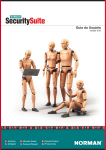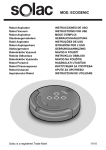Download Visa USA Presentation Template and User Guide
Transcript
Payment Processing Threats Impacting Grocery Store Merchants April 2013 Disclaimer The information or recommendations contained herein are provided "AS IS" and intended for informational purposes only and should not be relied upon for operational, marketing, legal, technical, tax, financial or other advice. When implementing any new strategy or practice, you should consult with your legal counsel to determine what laws and regulations may apply to your specific circumstances. The actual costs, savings and benefits of any recommendations or programs may vary based upon your specific business needs and program requirements. By their nature, recommendations are not guarantees of future performance or results and are subject to risks, uncertainties and assumptions that are difficult to predict or quantify. Assumptions were made by us in light of our experience and our perceptions of historical trends, current conditions and expected future developments and other factors that we believe are appropriate under the circumstance. Recommendations are subject to risks and uncertainties, which may cause actual and future results and trends to differ materially from the assumptions or recommendations. Visa is not responsible for your use of the information contained herein (including errors, omissions, inaccuracy or non-timeliness of any kind) or any assumptions or conclusions you might draw from its use. Visa makes no warranty, express or implied, and explicitly disclaims the warranties of merchantability and fitness for a particular purpose, any warranty of non-infringement of any third party's intellectual property rights, any warranty that the information will meet the requirements of a client, or any warranty that the information is updated and will be error free. To the extent permitted by applicable law, Visa shall not be liable to a client or any third party for any damages under any theory of law, including, without limitation, any special, consequential, incidental or punitive damages, nor any damages for loss of business profits, business interruption, loss of business information, or other monetary loss, even if advised of the possibility of such damages. Visa Public 2 Visa’s Multi-Layered Strategy Mitigating fraud through continuous leadership, coordination and investment Maintaining and enhancing stakeholder trust in Visa as the most secure way to pay and be paid PROTECT PREVENT Minimize fraud in the payment system Protect Trust vulnerable account data and Partnership ! ADVANCE Execute risk strategies for emerging products and channels RESPOND Monitor and manage events that occur Visa Public 3 Agenda • Common Security Deficiencies • Intruder Footprints • Attack Prevention • PED Tampering Cases • Preventive Measures for PED Tampering • Authentication Roadmap • What To Do If Compromised • Questions Visa Public 4 PCI DSS Requirements Commonly Identified Security Deficiencies Vulnerability Network Security Applicable Requirement Default or no firewall / router rules Requirement 1 No DMZ Requirement 1 Insecure remote access, no 2-factor authentication Requirement 8 Insecure operating systems and databases Requirement 6 No patching Requirement 6 No or outdated anti-virus signatures Requirement 5 No password management or access control lists (ACL) Requirement 7 Use of default or shared usernames and passwords Requirement 2 No system logging Requirement 10 No file integrity monitoring Requirement 10 SQL injection / other web-based exploits Requirement 6 No secure coding, independent code review, or penetration testing process in place Requirement 6 Incident Response No incident response plan Requirement 12 General No monitoring of systems, logs, access control, etc. Requirement 10 Host-based Security Application Security Lack of network segmentation has contributed to multiple location breaches Source: Data breach forensic reports Visa Public 5 Intruder Footprints • Malicious software – Memory parser malware that hooks on POS binaries • FIM with no password – Intruder whitelisted malware executable to prevent detection • Malware propagation – Used existing script to deploy malware at individual locations • Auto-login enabled – Credentials stored in the clear-text on Windows registry • Anti-forensic employed – Logs deleted – Encrypted output file using strong encryption Visa Public 6 The Attack Flow UNAUTHORIZED ACCESS Target of convenience. VPN credentials targeted (company users or third-party) ESCALATION & MODIFICATION PROPAGATION & CLEAN UP Using existing scripts and hardcoded password on POS, propagate malware to other store locations. Install other tools to delete hacker activities. Root level access on corporate network. Map out internal networks, target DCs, POS system and scripts. Modification to FIM. Visa Public EXFILTRATION Malware created files are encrypted and exfiltrated out of network. Method of exfiltration using existing ports (e.g., 443 with no filtering). 7 Vulnerabilities • No two-factor authentication on user access – VPN – Remote access • Lack of segmentation from corporate to store locations • Outbound firewall configuration allow connection to any IP on the Internet • Domain controllers targeted • Excessive permissions • Insecure POS systems (FIM with no password, autologin) • No incident response in place to detect malicious activity sooner Visa Public 8 Indicators of a Compromise (IOC) File Name Purpose File Size (bytes) MD5 Hash rtcli.dll Information stealer / downloader 118272 4bd819d9e75e4e8ecf1a9599f44af12a mstdc.exe Backdoor 64512 57703973ff74503376a650224aa43dfa mstdc.bak Backdoor 106496 67ed156e118b9aa65ed414a79633a3d4 msaudit.dll Memory parser malware 97792 27bfffa7d034a94b79d3e6ffdda50084 mn32.exe Prefetch file indicating execution of the malicious code 179200 89a8844c1214e7fc977f026be675a92a si.vbs Visual basic script used by hacker to deploy malware onto POS systems 2772 40efe7632b01116eefaba438c9bcee34 sd32.exe Anti-forensic utility to remove malware from POS systems 134000 9c3a1d3829c7a46d42d5a19fe05197f3 73728 cfee737692e65e0b2a358748a39e3bee 118784 85f94d85cfeff32fa18d55491e355d2b TcpAdaptorService.exe Memory parser malware Osql.exe, svchosts.exe Tool used in conjunction with TcpAdaptorService.exe to send track data to bad IP 122880 4b9b36800db395d8a95f331c4608e947 oposwin.exe Memory parser malware 245760 3446cd1f4bee2890afc2e8b9e9eb76a2 svcmon.exe Memory parser malware 253952 0fff972080248406103f2093b6892134 Visa Public 9 Indicators of a Compromise (IOC) File Name Purpose File Size (bytes) MD5 Hash nYmTxGSJhLLFfagQ.bat Batch file used to whitelist malware executables on FIM 74 eae4718ea5a860cc372b5728e96af656 tbcsvc.exe Performs cryptographic operations 293583 1aa662d329cc7c51d2e9176024fedee8 mssec.exe Attempts outbound communication via port 443 135242 d7e5e85ccb6c71a39b99a9228313cc33 msproc.exe Malicious unknown purpose 184128 2e567707730ed2c76b162a97dcf28c05 mpw.exe Custom password dumping utility based on pwdump6 151552 03462BD6A6008205264995BDEFEB027C msrclr42.dll Part of mpw.exe package 77824 4373855E29C40458552AB0463C3D4C4B mstdc.exe Apocalipto backdoor 64,512 57703973FF74503376A650224AA43DFA N/A Binary payload for apocalipto backdoor 49,664 9A460FA6F9F56415E3BA23667718039D MSTDC.BAK Apocalipto backdoor 106,496 67ED156E118B9AA65ED414A79633A3D4 N/A Binary payload for apocalipto backdoor 49,152 751363A08365925B7C7A4ED8755B090D rtcli.dll Downloader and Internet Explorer information stealer 118,272 4BD819D9E75E4E8ECF1A9599F44AF12A mstsk.exe DNS-based backdoor 45,568 43D77242910BABE51CB12C25371CC5AC Visa Public 10 Attack Prevention - Overview • Network Security • POS Security • Administrator Accounts • Incident Response Visa Public 11 Network Security • Apply a defense-in-depth approach to protect the most critical resources on your network, including POS systems • Limit access to only network ports and services that are necessary to perform desired business functions • Segregate the payment processing network from other non-payment processing networks • Users with administrative access should use two-factor authentication when accessing the payment processing networks • Apply access controls on the router configuration to limit unauthorized traffic to the payment processing networks • Implement strict inbound and outbound filtering on the firewall rule sets Visa Public 12 POS Security • Implement P2P PEDs • EMV capability • Secure Reading and Exchange of Data (SRED) • Hardware-based encryption • Install PA-DSS compliant payment applications • Deploy the latest version of operating system and ensure it is up-todate with security patches, anti-virus, FIM, HIDS • Perform a binary or checksum comparison • Disable unnecessary ports and services, null sessions, default users and guests • Enable logging of events and make sure there is a process to monitor logs on a daily basis Visa Public 13 POS Security - Continued • Implement least privileges and access controls lists (ACLs) on users and applications on the system • Implement a security policy that includes operating system security configuration. The policy should include the following: – Security installation guide – Password management guide to manage users on the system – Mechanism to ensure consistent security baseline on critical systems Visa Public 14 Administrative Accounts • Use two-factor authentication when accessing the payment processing networks • Limit administrative privileges on applications • Periodically review systems (local and domain controllers) for unknown and dormant users. • Apply same security on database users Visa Public 15 Incident Response • Deploy Security Information and Event Management (SIEM) • Review logs and offload to a dedicated server (e.g., syslog and in a secure location where hackers can’t tamper with logs) • Invest in an incident response team • Knowledge • Training • Certification • Test your incident response plan • Implement IOC signatures on your solution Visa Public 16 PIN Entry Device (PED) Tampering Cases Number of PED tampering cases increasing – Criminals target merchants with certain PED models • Attacks on older vulnerable PEDs and newer PED models • Wireless models becoming a target – Small and large merchants, often multiple stores, targeted • Swap out PEDs with altered PEDs Attacks are more sophisticated & technically advanced – Recent attacks involved VeriFone Everest and Ingenico i3070 PED models – However new PED models are being targeted Evidence of technology being exported globally PED Tampering usually involves: – A second mag stripe reader or connection to existing reader – Keypad membrane – Additional circuit board(s) – Flash memory chip or drive Visa Public – Bluetooth device 17 Preventive Measures for PED Tampering • • Replace vulnerable PEDs as quickly as possible Train staff to regularly inspect PEDs visually to identify anything abnormal such as • • • • Missing or altered seals or screws Extraneous wiring, holes in the device, or the addition of labels Overlay material used to mask damage from tampering Ensure PEDs are physically secured / locked down to counters Review Visa’s Terminal Usage Best Practices: “Point-of-Sale Terminal Tampering Is a Crime …and You Can Stop It” www.visa.com/cisp Visa Public 18 Compromised PIN-Entry Device List • Review PEDs in use to identify any known vulnerable devices • Visa Bulletin available on www.visa.com/cisp • Take precautions to secure all PEDs in use…or in storage Visa Public 19 Merchant Best Practices to Prevent Skimming 1. Implement a terminal authentication system to detect internal serial number or connectivity changes 2. Secure terminals / PEDs to counters to prevent removal and secure cable connections 3. Inspect and secure PEDs within unattended self checkout lanes 4. Use terminal asset tracking procedures for devices deployed, stored and shipped 5. Secure stored PEDs and validate inventory against asset records www.pcisecuritystandards.org/documents/skimming_prevention_IS.pdf Visa Public 20 Authentication Roadmap U.S. EMV chip roadmap supports three primary opportunities 2 3 Support interoperability and improve authorization decisions as EMV adoption continues to grow worldwide Global U.S. 1 Build framework for mobile payments and future innovation leveraging EMV infrastructure for both contact and contactless payments Reduce reliance on static data and incidence of counterfeit fraud 2011 2012 2013 2015 2017 Guide and Enforce Security Standards Technology Innovation Program (TIP) Acquirer Chip Processing1 POS Liability Shift1 ATM & AFD Liability Shift1 2011 2012 TIP2 POS Cross-Border Liability Shift (excluding U.S.) Promote adoption of dual-interface chip terminals Counterfeit fraud liability shift applies to contact only and dual-interface 1Dates 2Visa and/or timelines may change Europe announced a corresponding program Visa Public 21 Encouraging Terminal Adoption U.S. Building processing infrastructure for chip and mobile acceptance 2011 2012 2013 2015 2017 Guide and Enforce Security Standards Technology Innovation Program (TIP) Acquirer Chip Processing1 POS Liability Shift1 ATM & AFD Liability Shift1 • TIP recognizes and incents merchant chip investments, while maintaining expectation for merchants to protect cardholder data • Mandate for U.S. acquirer processors and sub-processor service providers to support chip processing, effective April 1, 2013 • Participation results in cost savings by waiving the annual PCI DSS validation exercise • Acquirers must certify the ability to comply • Eligible merchants must meet all of the minimum qualification criteria • Visa will require support of Field 55 and additional related chip fields for VIP authorization messages between the acquirer and Visa • Acquirers should also ensure downstream connections certify to their own platforms prior to the deadline – PCI DSS compliance or remediation plan – No storage of prohibited data – At least 75 percent of merchants’ transactions must originate from dual interface chip terminals and can process end-to-end chip transactions – No involvement in cardholder data breach2 1Dates and/or timeline may change previously involved in a breach may qualify if they have completed subsequent PCI DSS validation 2Merchants Visa Public 22 Managing Liability U.S. Liability shift rewards the entity making the investment in EMV. It is not a mandate to issue or accept chip cards 2011 2012 2013 2015 2017 Guide and Enforce Security Standards Technology Innovation Program (TIP) Acquirer Chip Processing1 POS Liability Shift1 ATM & AFD Liability Shift1 • Visa intends to establish a U.S. liability shift for domestic and cross-border counterfeit POS transactions • If a card is contact chip-capable and the merchant has not invested in chip, liability for counterfeit fraud will shift to the Acquirer • The chip card’s counterfeit fraud protection plus the liability shift encourage issuer chip adoption by providing dynamic authentication that helps better protect all parties • The liability shift does not cover Product Type Contact Chip or Dual Interface Merchant Terminal Liable Party Magstripe Only Liability Shifts from Issuer to Acquirer Note: When a chip-on-chip transaction occurs, in the unlikely event there is counterfeit fraud, liability follows current Visa International Operating Regulations – Cards without a contact chip – Card-not-present transactions – Lost-and-stolen fraud 1Dates Liability Shift and/or timelines may change Visa Public 23 What To Do If Compromised • Take compromised system off the network • If you must rebuild system, take a forensic image prior to rebuild • Review firewall configuration and disable any unnecessary inbound and outbound traffic • Pair down ACLs, ports and services between PCI and non-PCI environment • Create strict ACLs segmenting public facing systems and backend database systems that house payment data (e.g., DMZ) • Change all passwords on the network including applications and local accounts • Review all access to the payment processing environment and terminate connectivity Visa Public 24 What To Do If Compromised • Notify your acquiring bank • Engage a PCI Forensic Investigator (PFI) https://www.pcisecuritystandards.org/approved_companies_pr oviders/pci_forensic_investigator.php • For more information, please refer to Visa’s What To Do If Compromised, available at www.visa.com/cisp under the ”If Compromised” section • You can also contact Visa Fraud Control and Investigations at [email protected] or (650) 432-2978, option 4 Visa Public 25 Questions?





























